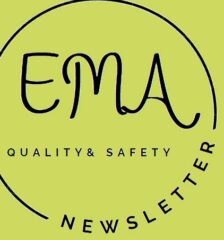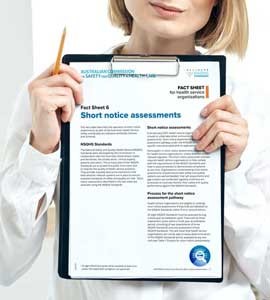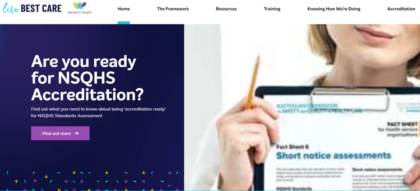Filter by

The Clinical Communiqué is an electronic publication containing narrative case reports about lessons learned from Coroners’ investigations into preventable deaths in acute hospital and community settings. The Clinical Communiqué is written by clinicians, for clinicians.
Associate Professor Nicola Cunningham
There are many ways by which we come in selecting our themes for the Clinical Communiqués. Sometimes it will be a single coroner’s finding that leads us toward a particular diagnosis or contributing factor. Occasionally it is a conversation with a colleague about an area of concern
that we know needs to be highlighted. Other times it is a tragic cluster of cases that we just cannot look past, or a pressing systemic issue that
we need to add our voice to. Every now and then however, an edition, such as this one, begins with the planting of a seed, an idea born from our own experience, cultivated by chance encounters with the right people at the right time, and brought to fruition by their unwavering conviction
to improve the healthcare system. The Clinical Communiqué becomes the instrument that brings those people together to help share powerful
lessons with our healthcare community. It is a privilege for our publication to be a part of that process. A few months ago, I was sitting in a
room full of people – of all nationalities and professions, and we were coming to the end of an intense and thought-provoking cultural Safety
training workshop. There are many ways to define cultural safety in health care. At its core is the notion of establishing respect for culture in health, addressing unconscious bias, racism and discrimination, and ensuring the safe experience of the recipient of care. Culture is not homogenous or static. It is an ever evolving and deeply individualized construct. The training I undertook consisted of six weeks of reading and completion of modules, followed by a full-day face-to-face workshop. I had learnt a lot, wanted to know more, and wondered why it was only then, after more than two decades of work as a medical practitioner, that I was experiencing this fundamental training in such an immersive and impactful way. I raised my hand and asked the facilitator what it might take to make cultural safety training tools like that workshop available to all healthcare professionals. Around that same time, I had come across two coroners’ findings that were the first I had seen to describe a lack of cultural safety as a contributing factor in preventable hospital deaths. A line from one of the findings stuck with me, “It was necessary to place [the patient’s] care within the context of the well-known disparity between the health outcomes of Aboriginal people and those from the non-Aboriginal population, but also to place it in the context of the specific community and family dissatisfaction which was reported… [which together] make it essential not to shy away from the issue or sweep it under the carpet for fear of causing offence.”1 I realised that the Clinical Communiqué was one way in which we could put a spotlight on the issues and the need for cultural safety training in our profession. The course facilitator that day was Mr Olli Wynyard Gonfond, a program designer who brought a confronting honesty and infectious enthusiasm to our learning, and who went on to become a contributor to this important edition. The other contributors were equally inspiring and gracious in their acceptance of my invitation to guide and contribute to this edition on cultural safety. It was crucial that we engaged First Nations People to lead this project – from the conception of the edition to the content and creative design. We respected their input, and in turn, they trusted us to deliver their messages.
We are wholly indebted to Dr Jordana Stanford, a resourceful early career clinician; Dr Glenn Harrison, a respected clinical leader; Ms Jacqui Gibson, an established consumer expert; and Ms Belinda Gibb, an innovator in education and policy, for their contributions to this edition which features key insights and practical advice on how we must improve cultural safety in health care.
It is a commonly heard phrase in patient safety, that clinicians don’t go to work intending to harm patients – but we know that the systems and environments in which we work can set us up to cause unintentional harm. I believe the same can be said about cultural safety in health care. Individuals don’t go to work intending to be racist – but the systems, processes, resource disparities, and cognitive biases that exist in every workplace create traps where actions and words are culturally unsafe. We may not see it when it happens, or fully understand why it happens, but what becomes clear to all is the potential harm that it causes to patients.
We make no apologies for any discomfort our readers may feel with what follows in this edition. Discomfort may be a negative emotion, but it can also generate a positive action. In medicine, discomfort points to the site of pain. It localises the problem that needs to be addressed. Reading these patients’ stories where a lack of cultural safety led to tragic consequences should be uncomfortable. Do not look past this, because what you ignore you are tacitly agreeing to, and what you discount as someone else’s problem belongs to everyone. Doctors are the cultural lead for clinical teams in health care, so embrace the discomfort and recognise that we are part of the solution.
|
|
|
|
|
|


Throughout February the Division has commenced work on several key improvement initiatives. One of these improvement initiatives is the Timely Emergency Care Collaborative (TECC). This is a project supported by Safer Care Victoria and is being implemented across several Victoria Health Services. The aim is to improve both Emergency Department and Inpatient flow to provide safe and best care to our patients. There are three different work streams being led by the EMA leadership team with membership across all disciplines.
We also continue to focus on readiness for EMR Phase 2.1 and are encouraging all departments to ensure they have sufficient staff trained as Super Users. This is an opportunity to expand already existing skills and learn about new features to be able to support your teams.
In order to ensure we feel prepared and staff are supported through the short notice accreditation process, there are a range of resources on the Live Best Care intranet site. Please ensure you are familiar with this site.
We welcome your feedback and contribution. We would love to hear about improvement projects or patient stories that highlight the great care you provide. All contributions and feedback can be emailed to the editorial team at: EMAQuality&Safety@wh.org.au

Karen presented to the Sunshine Emergency Department on Sunday afternoon with difficulty breathing. From the Emergency Department Karen was admitted to SSU then transferred to RADU.
Karen provided the ED team with a medication list she was given on a recent discharge from Western Health. Karen stated not all of her medications were charted in ED or SSU from the list and she did not receive all of her usual medications until she was admitted to RADU more than 24 hours from when she presented to ED. She missed her usual doses of antidepressant and Symbicort. Some of the medications that were charted in ED were not her usual doses. This has all been resolved now.
Karen stated that the nursing staff check her ID band and ask what she is allergic to before giving medications, however didn’t have her ID band scanned prior to medication administration. Karen stated she still has information about her medication from her previous stay in hospital and she has been seen by the ward pharmacist who has reviewed her list of medication and crossed out the medications no longer required or charted. Karen stated this was a great help to understanding her medications.
Karen would like the doctors to inform the nurses when they change medications as the nurses are often confused about why the changes have occurred. Karen would also like to know when her medications have been changed or stopped.

A 20-month-old boy arrested in SHED, was resuscitated and transferred to RCH Paediatric Intensive Care Unit. He had septicaemia with Group A Streptococcus and Influenza A co-infection.
During his extended resuscitation in SHED, his family were supported by a member.
of the ACE team, Stephanie Dragwidge. Stephanie sat with his parents, communicated with them via a Vietnamese interpreter and explained the medical interventions to them.
The parents were given instructions on how to get to the PICU at RCH, however Stephanie identified that the family were going to struggle to get to RCH from SHED and then find their way through to PICU. Stephanie took the initiative to accompany his parents to RCH, escorted them to the PICU and facilitated their introduction to the RCH Team.
Thank you Stephanie!
There are multiple improvement initiatives underway across EMA. Do you know about these?
2G RADU discharge improvement project that aims to:
- Develop a discharge checklist in EMR
- Improve utilisation of Criteria-Led Discharges
- Standardise MDT huddles
Mechanical restraint improvement group focusing on improving compliance with the Mental Health Act when restraints are being used. Various activities include the creation of a dashboard and WeLearn modules, updating the PPG, in-services and tutorials and developing forms within EMR.
Ambulance Victoria Offload Improvement project aiming to improve the times to transfer patients from an AV stretcher to provide better care to our patients and community.
Transfer of Emergency Department patients to Radiology – aiming to reduce time delays from imaging request to completion thus improving patient experience and efficiency.
EMA ward comprehensive care project that focuses on improving rates of falls and pressure injuries across our wards via a standardised approach. A working group is currently being formed by FHED to implement a similar project across the Eds and UCCs.
The Quality EDucation framework continues each month with a plan to include medical teams.
We are proud of…
- Opening the Sleep Lab to full capacity
- Welcoming two new Nurse Unit Managers to the Division. Anita Toumbourou has commenced on F-2B and Ben Crowther has commenced on S-3E
- Having two consecutive months with both Falls and Hospital Acquired Pressure Injuries per 100 bed days being below the median
- Achieving 60.3% in AV offload performance in February
We are looking forward to…
- Preparation for EMR Phase 2.1 Go Live
- Accreditation readiness
- Ongoing improvement cycles around access initiatives
- Monitoring and understanding utilisation of additional care resources
- Progressing excess annual leave management plans
Our focus continues on…
- Falls across both our Emergency Departments and inpatient areas
- Improvements in our hand hygiene and infection prevention practices
- Ensuring we weigh our patients at both admission and weekly
- Providing best care to our patients
- Improving our times to transfer patients off AV stretchers
|
Data Analysis |
Key Message |
||
|
Hand Hygiene |
Overall Hand Hygiene compliance for the Division was 81% in February 2023 – this includes our Urgent Care Centres. Well-done to 2G for achieving 98% compliance! | Don’t forget to replace the end of bed alcohol based hand rub if empty. If you do not know where to get a new bottle from in the ward or department, please let the nurse in charge know. | |
| Healthcare Associated Infections | Nil identified this month | Remove unnecessary cannulas as soon as possible. | |
|
Medication Errors |
|
Don’t forget the 5 Rights for medication safety |
|
|
Comprehensive Care—Falls, Pressure Injuries and nutrition |
There were 47 falls across the Division this month. One incident in SHED results in #NOF and was confirmed as a Serious Adverse Patient Safety Event (SAPSE). Patients being treated by EMA medical teams have had fewer falls per 100 bed days for the past 2 months when compared to other patients. There were 12 hospital acquired pressure injuries recorded for EMA in February. Weekly weight compliance across division is 80% and on admission is 63% |
Supervise patients at risk of falling in bathrooms and toilets. Complete risk assessments and implement appropriate prevention strategies as soon as possible. |
|
|
Mechanical Restraint |
Compliance of documentation regarding mechanical restraint continues to be a challenge with improvement opportunities in documentation of alternative strategies, consent, 4-hour medical reviews, restraint releases, skin checks, access to toileting and hydration. |
Use least restrictive practice, review and remove as soon as possible. Ensure it is documented |
|
| Communicating for Safety | Incorrect pathology labelling continues to be a challenge. | Check patient details before and after collecting specimens. | |
| Blood Management | There were 5 incidents related to Blood and Blood products across the division in February. | Complete your mandatory training via WeLearn | |
| Recognising and responding to Acute Deterioration | There were 170 Adult MET calls and 5 Code Blue calls in EMA in February (1.9 per 1000 admissions- down from last month). One of the Code Blue calls required CPR. |
See more about Standard 8: Deteriorating Patient |
| Incidents and Complaints | There was a total of 413 incidents across all standards for our division this month. We received 34 complaints in February. | Standard 1 and Standard 2 |

Welcome to the March 2023 NSQHS Accreditation Bulletin.
This publication has been developed to provide key messages and information about preparing for org-wide NSQHS Accreditation Survey.
For those who would like to just view a summary of this Bulletin, click on the three headings below:
- Key Messages March 2023
- Upcoming Milestones
- Contact for Accreditation Questions/Support
For those who would like a more comprehensive read, continue reading the Bulletin sections below or select areas of interest from the index to the right.
Best Care Governance & Support Division
The National Safety and Quality Health Service (NSQHS) Standards provide a nationally consistent statement of the level of care consumers can expect from health services.
Western Health undergoes mandatory assessment (accreditation survey) against the NSQHS Standards.
NSQHS Standards compliance activity and accreditation surveys supports us to monitor, review and continually improve Best Care.
The eight NSQHS Standards are:

- From 1 July 2023, there will be no scheduled accreditation surveys; only short-notice assessments with 24 hours notice
- As WH’s current NSQHS Accreditation status lapses in May 2024, we will have a short-notice assessment at some point between 1 July 2023 and 31 December 2023.
- We will have a team of approximately 13 accreditation surveyors visiting all of our campuses and over a week
- Transitioned mental health services will be included in survey; still determining if Dame Phyllis Frost will need to be included
- Surveyors will spend up to 75% of survey time in clinical wards and departments
Use one word to describe how you feel about scheduled NSQHS Accreditation surveys changing to short-notice surveys
NUM Group:

 ACHS (our accreditation surveyors) are still trying to work out how short notice assessments will be co-ordinated.
ACHS (our accreditation surveyors) are still trying to work out how short notice assessments will be co-ordinated.
While waiting for guidance, we are working on a NSQHS Standard short notice response plan that will be activated within the 24 hour notification period.
A mock activation of this plan will be held in May
We are also developing the WH Live Best Care microsite as a central NSQHS Standard evidence portal for Surveyors while on site at WH.
How well do you feel Western Health would do if Surveyors turned up tomorrow for an Accreditation Survey?
NUM Group:

New (‘Fab 5’) teams commenced in October last year. Each team has a nursing, medical, allied health, education and quality lead. They are working in conjunction with key WH committees to support ongoing organisation-wide compliance with each NSQHS Std.
There is a dedicated page for each NSQHS Std on the Live Best Care site where Team output is being developed as a Surveyor evidence portal.

Led by Nursing Leads (DONMs) and supported by business as usual (BAU) Action Plans, each Fab 5 Team has been working on actions to address identified NSQHS Std practice gaps.
See the graphic below for a sample of current areas of focus for practice improvement.

Keeping with the BAU theme, the papers of aligned WH Committees have been designated as core evidence of compliance with NSQHS Standards.
To support this function, the BCGS Division has generated a SharePoint 365 site to house the governance information and papers for all Best Care Committees.

What are the main things you think will stop us being sustainably accreditation-ready into the future?
NUM Group:

 A NSQHS Standard Accreditation communications and engagement plan that is considerate of how busy services are and the volume of change activity occurring in 2023 is currently being finalised, with implementation to commence in mid/late March.
A NSQHS Standard Accreditation communications and engagement plan that is considerate of how busy services are and the volume of change activity occurring in 2023 is currently being finalised, with implementation to commence in mid/late March.
Underpinning the activity within this plan is the messaging of ‘Everyday we Live Best Care’.
The following graphic outlines key initiatives included in the communications and engagement plan to support staff be ‘Accreditation Ready’ by end June this year.

The Live Best Care Microsite is our central information portal for staff on WH’s Quality Systems supporting Best Care and compliance with NSQHS Standards
A New section under ‘Accreditation’ has just developed – ‘Are you ready for NSQHS Accreditation?’ … contains FAQs and links to resources to help staff be ‘Accreditation Ready’
Available resources will grow over next few weeks.

Have you visited the refreshed Live Best Care site?
NUM Group:

 In mid/late March, there will be a call out for improvement activity completed since March 2020 to be recorded on the WH Improvement Register.
In mid/late March, there will be a call out for improvement activity completed since March 2020 to be recorded on the WH Improvement Register.
 Pending a pilot outcome, there will also be a launch in April 2023 of a new platform to support new quality improvement project planning, implementation and reporting across WH. This platform is called ‘LifeQI’.
Pending a pilot outcome, there will also be a launch in April 2023 of a new platform to support new quality improvement project planning, implementation and reporting across WH. This platform is called ‘LifeQI’.
 Items pulled from the Improvement Register and LifeQI will be show cased on the Live Best Care site.
Items pulled from the Improvement Register and LifeQI will be show cased on the Live Best Care site.
First and foremost continue the messaging and BAU activity that helps our staff to ‘Everyday Live Best Care’.
From a practical ‘accreditation readiness’ perspective:
- Get any out-of-date PPGs under control, including non-integrated BMM procedures
- Lift staff engagement in mandatory training and PDPs
- Become familiar with the Live Best Care microsite and consider how the resources on this site could be used in a meaningful way to support staff be ‘accreditation ready’.
- Consider how to support staff be involved in BAU audit activity that may have slipped (eg Infection Prevention auditing)
- Consider how the language and focus of the NSQHS Accreditation Standards can be factored into BAU activity … the new EMA Quality & Safety Newsletter is a great example.


Health services will be better able to monitor and manage demand for planned surgery with the launch of the new Planned Surgery Monitoring Dashboard on the VAHI portal. The dashboard launched in late February for authenticated users, providing a powerful new tool to review, compare and monitor planned surgery.
Thousands more people have been able to share their healthcare experiences through the Victorian Healthcare Experience Survey (VHES) program, following a shift to electronic-only collection last year. The major boost in participation is leading to much more detailed patient experience data being available down to ward level, with health services excited about the new opportunities to target and evaluate improvement activities.
Clinical corner is back for another month, looking at the ‘illusion’ of safety. Dr Graeme Duke dives into the differences between taking a Safety I or Safety II approach, and how it’s important to improve safety by learning from success, as well as reduce harm by learning from failure.
Finally this month, the National Disability Data Asset (NDDA) project is moving towards new milestones, with data intake and linkage expected by the end of the year. The NDDA is a crucial project that will lead to transformational change to data linkage capability at a national scale and it is great to see it taking shape under the auspices of the Centre for Victorian Data Linkage (CVDL).
And don’t forget to subscribe to VAHI news if you haven’t already, and encourage your colleagues to do the same. It’s the best way to keep up to date with all the latest from VAHI. Likewise, if you’ve got a story to share about how VAHI data has helped you, we’d love to hear it. Contact Jeremy Kennett in VAHI Communications at jeremy.kennett@vahi.vic.gov.au
Sincerely,
Dr Lance Emerson, CEO
Interactive dashboard delivers new ways to monitor and improve planned surgery performance
A new dashboard will allow health services to better monitor planned surgery and compare and investigate their performance data.

Electronic shift delivers huge participation boost to patient experience program
More than 10,000 extra Victorians have had the chance to share their healthcare experiences, following a shift to electronic-only data collection for the Victorian Healthcare Experience Survey (VHES) program.

Seeing to the heart of quality and safety
What do you see when you first glimpse this drawing- the old woman or young lady?

New data asset to improve disability support and linked data capabilities in Victoria
A new linked data asset that will produce insights on the outcomes of people with disability and their pathways through services is set to transform the capability of data linkage.


 A big thank you to everyone as we continue to provide Best Care to an increasing number of people from our community as we also prepare for the introduction of EMR Phase 2.1 and short notice accreditation.
A big thank you to everyone as we continue to provide Best Care to an increasing number of people from our community as we also prepare for the introduction of EMR Phase 2.1 and short notice accreditation.
From the 1st July, Western Health may undergo NSQHS accreditation with only 24 hours’ notice. In the past we have worked toward accreditation to an allocated date some months out from the surveyors arriving on site. As some of you may recall, we last underwent accreditation in March 2020, just as COVID arrived on our shores.
We know the surveyors will spend much more time on our clinical wards and departments (target of 75% of their time compared to 60% in 2020) and our evidence of compliance needs to be more evident and accessible than previously required. We are working on a business as usual approach.
Our Best Care team have developed a range of resources on the Live Best Care intranet site. We ask that you start to familiarise yourself with the site. A good place to start is on the ‘Are you ready for NSQHS Accreditation?’ page.
We welcome your feedback and contribution. We would love to hear about improvement projects or patient stories that highlight the great care you provide. All contributions and feedback can be emailed to the editorial team at: EMAQuality&Safety@wh.org.au
 At the February Q&S meeting, we heard from Ward 2C team at Footscray who have been caring for a patient who was admitted with complex medical and social needs.
At the February Q&S meeting, we heard from Ward 2C team at Footscray who have been caring for a patient who was admitted with complex medical and social needs.
On admission the patient was identified as a high Occupational Violence and Aggression (OVA) risk, with multiple code greys and 2 code blacks called. The patient required 24/7, 1:1 observation to ensure his safety and the safety of staff and visitors.
The team developed a multidisciplinary approach behavioural support plan which included review and changes to medications, planned code greys to assist with care interventions and diversion activities. With the implementation of many strategies, the patient’s behaviour has improved and he is now mainly compliant with care interventions.
This is a great example of providing Best Care for our most vulnerable complex patients. Thank you to all involved.
 Thank you To Gary Ayton, From SHED Registrars Krishna and Ellie for loan of camping equipment
Thank you To Gary Ayton, From SHED Registrars Krishna and Ellie for loan of camping equipment
“Thank you for being a wonderful, generous and kind consultant to us all. You have really taken us under your wing and given us all your expensive gear to use on our Australian adventures….keep going with convincing the new Brits to get out and explore- we are grateful you made us!”
There are multiple improvement initiatives underway across EMA. Do you know about these?
- Introduction of new ED registrar non-clinical position – education to complement existing Simulation registrar role
- Introduction of generic action cards for JRMOs at SHED to ensure they all know the main priorities of their roles in ED.
- SHED relocation of AV offload cubicles from old EOU to cub 11-20 – this should provide greater flexibility in patient selection for offload from AV and improve AV offload times by reducing existing barriers. SHED are on target to achieve the best AV offload result in a month since December 2020!
- Commencement of the new MH and AOD Outreach Community Service which will assist in supporting the SHED Hub.
- Participation in the “Timely Emergency Care Collaborative” – Safer Care Victoria supported project to improve both ED and inpatient flow.
- Introduction of a stamp to go on SHED ECGs to improve documentation of time and assessment of ECGs by ED consultants.
- QualityEDucation framework has been relaunched with each month dedicated to a standard and embedded through key themes of the week.
- ED guideline for the management of fractures and soft tissue injuries- Guideline available on prompt or scan the QR code available on posters in Fast Track.
We are proud of…
- Progression and closure of outstanding preliminary reviews and actions resulting from serious adverse events
- Professor Tissa Wijeratne recognised with a Medal of the Order of Australia (OAM) for service to medicine as a Neurologist
- Finalising outstanding Policies, Procedures and Guidelines (PPGs)
- Improved compliance of alcohol based hand rub available at the bedside across all patient wards
- AV offload improved by 7% across WH
- Recruited to Nurse Practitioner Candidates roles in Emergency Medicine
We are looking forward to…
- Reducing endoscopy waitlist via additional lists at Western Gastroenterology Services, Werribee Mercy, Bacchus Marsh, Sunbury and Sunshine sites
- Monitoring and understanding utilisation of additional care resources
- Participation in Timely Emergency Care Collaborative initiatives
- Progressing excess annual leave management plans
Our focus continues on…
- Providing best care to our patients
- Being kind to each other
- Preparing for short notice accreditation
- EMR 2.1 implementation
- Recruitment to vacant EFT
|
Data Analysis |
Key Message |
|
|
Hand Hygiene |
Overall Hand Hygiene compliance for the Division was 89% in January 2023. A number of areas remained below the target of 90%, namely F2D 79%, F2C 89% and WTN ED 89%. | Don’t forget to replace the end of bed alcohol based hand rub if empty. If you do not know where to get a new bottle from in the ward or department, please let the nurse in charge know. |
| Healthcare Associated Infections | Staph.aureus Bacteraemia (Healthcare associated) PIVC related- SH3F. Confirmed SAPSE | Remove unnecessary cannulas as soon as possible. |
|
Medication Errors |
A slight decrease in the total number of medication errors for January – 37. Twenty – two of these were APINCH medications |
Don’t forget the 5 Rights for medication safety |
|
Comprehensive Care—Falls, Pressure Injuries and nutrition |
A total of 60 falls were recorded in our departments in January. All incidents were categorised as an ISR 3 or 4 incident. Median of 0.58 falls per 100 bed days (all ages) and 0.68 falls per 100 bed days for >65 years of age. There were 8 hospital acquired pressure injuries recorded for EMA in January. Weekly weight compliance across division 80%. |
Supervise patients at risk of falling in bathrooms and toilets. |
|
Mechanical Restraint |
Compliance of documentation regarding mechanical restraint continues to be a challenge with improvement opportunities in documentation of alternative strategies, consent, 4-hour medical reviews, restraint releases, skin checks, access to toileting and hydration. |
Use least restrictive practice, review and remove as soon as possible. Ensure it is documented |
| Communicating for Safety | Incorrect pathology labelling continues to be a challenge. | Check patient details before and after collecting specimens. |
| Blood Management | EMA did not report any blood management incidents in January. | Complete your mandatory training via WeLearn |
| Recognising and responding to Acute Deterioration | There were 284 Adult MET calls and 10 Code Blue calls in EMA in January 3.0 per 1000 admissions – up from 2.4 in December. One of the Code Blue calls required CPR. |
See more about Standard 8: Deteriorating Patient |

The Clinical Communiqué is an electronic publication containing narrative case reports about lessons learned from Coroners’ investigations into preventable deaths in acute hospital and community settings. The Clinical Communiqué is written by clinicians, for clinicians.
Associate Professor Nicola Cunningham
Welcome to the third edition of the Clinical Communiqué for 2022. Our readers will recall that our previous edition, the Clinical Communiqué June 2022, was our milestone 20-year edition, and we were honoured to mark the occasion with a collection of compelling and insightful
commentaries from leaders in the patient safety movement of the past two decades.
It was a substantial edition, our biggest undertaking to date, with an enormous amount of content to digest. Our experts offered their lessons learned and sage guidance for a better future, crafted from a wealth of knowledge, experience and determination in their hard-fought efforts to improve the quality and safety of patient care.
I strongly recommend that you revisit the edition as you will discover more gems each time you come back to it. Use the commentaries as a platform for ideas that you want to test or introduce in your own workplaces. Discuss the ideas with your peers, in your tea breaks, handovers, journal clubs, teaching sessions, and at grand rounds.
Momentum is the key to achieving change, and collective efforts to drive action is what will bring about systems changes in healthcare.
In this edition, we return to our familiar format of presenting coroners’ case summaries with an expert commentary that explores some of the themes identified in the cases. We highlight two cases, both involving post-operative patients, where electronic alerts were overridden and
criteria for escalation were met but not actioned. These cases introduce the concept of alarm/alert fatigue (terms used interchangeably) and failure to escalate care/failure to rescue.
This publication has regularly focused on learning from recurring errors. Things that keep happening but shouldn’t. Whether it is alarm fatigue from multiple alerts that cause annoyance and fade into seeming inconsequence before being deleted from the desktop of consciousness,
or a failure to escalate care due to a confusion between ‘not changing’ and ‘stable’, the commonality is a lack of focused attention. For an individual this can be exacerbated by fatigue or the ‘automatic processing’ type of thinking that occurs when performing routine tasks.
For a team, the relative strength of an alert signal can be muffled by barriers to communication, a perceived lack of safety in speaking up, and a tendency towards ‘belief similarity’ with the person immediately occupying the highest point of the hierarchy.
How can we develop our teams to share the burden of risk management responsibilities at every level and make safety behaviours the new model of success? We do this by using technology in a smart way to support our decisions, and creating environments where our teams understand risk and are not just empowered, but directed to re-focus our attention when needed.
Our expert commentary, which includes a sophisticated and holistic approach to risk management interventions, is by Dr David Bramley, a senior anaesthetist with extensive experience in designing safer systems in healthcare. He has worked on ANZCA’s Professional Guideline for the safe management and use of medications in anaesthesia, was Chair of Western Health Medication Safety Committee during Electronic Medical Record (EMR) implementation, and acted as a Consultant to the Victorian Therapeutic Advisory Group on a number of hospital
safety issues. He is currently employing his clinical risk expertise in the most practical way possible, as the medical lead contributing to the design of a new build hospital
|
|
|
|
|
|

- Primary and Community Healthcare Standards guide
- Accreditation begins soon for clinical trials
- Help shape the future of clinical quality registries
- Get familiar with the mental health standards for CMOs
- New data reinforces antimicrobial resistance priorities
- Transition of Quality Use of Medicines programs
- Meet Suchit Handa, Director, Safety and Quality Improvement Systems
Work in allied health or have an interest in primary care? We’re keen to get your thoughts on the National Safety and Quality Primary and Community Healthcare Standards Guide for Healthcare Services.
This comprehensive guide to accreditation to the standards includes practical guidance and examples of evidence that services can use to implement the actions in the Primary and Community Healthcare Standards. Share your feedback before 28 February.

In March, accreditation to the National Clinical Trials Governance Framework will begin for all health services conducting clinical trials in alignment to the National Safety and Quality Health Service Standards.
To assist implementation, the Commission has developed new resources, including a tool to conduct a self-assessment, manage examples of evidence and report on trial operations.
Organisations can also access direct support through the Safety and Quality Advice Centre, and join preparatory information sessions to learn more.

Clinical quality registries support the delivery of better value care, improve patient outcomes and are a critical part of health infrastructure.
Public consultation on the Framework for Australian clinical quality registries Second Edition is now open. The Commission is seeking feedback on the revised Framework, local design and infrastructure, and security compliance guidelines.
Have your say on the updated Framework to shape the future of this valuable health asset.

The Commission launched new mental health standards for Community Managed Organisations (CMOs) late last year. These standards aim to continuously improve the quality of mental health service provision in community settings and to protect service users from harm.
Access the standards and learn more about the next steps for accreditation.

The AGAR Surveillance Outcomes Programs 2021 Report showed that episodes of bloodstream infection were overwhelmingly community-onset and commonly associated with urinary tract infections and the bacteria Escherichia coli and Staphylococcus aureus. Cross- and co-resistance to antimicrobials commonly used in the community may be driving increased resistance to some antibiotics.
Antimicrobial use and appropriateness in the community: 2020-2021 reported that while there was a dramatic decline in antimicrobial use during 2020 and 2021 that coincided with the pandemic response, there is room for improvement in prescribing antimicrobials.

As of 1 January 2023, a range of Quality Use of Medicines (QUM) functions have transitioned to the Commission, as outlined in the redesign of the Quality Use of Diagnostics, Therapeutics and Pathology program in the 2022-23 Federal Budget.
These functions were previously provided by NPS MedicineWise, and over the past three months our organisations worked closely together to support this change.
Now that the initial transition has occurred, the Commission will be reviewing the operation of the functions and programs with a view to identifying opportunities for improvement and aligning national work on QUM.
The Commission will be working closely with consumers, general practitioners, pharmacists and other clinicians as review processes commence.
For more information, visit Quality Use of Medicines or email QUMProgram@safetyandquality.gov.au.

Short notice assessments will commence from 1 July 2023. This change applies to all health service organisations where licencing requires accreditation to the NSQHS Standards, including hospitals and day procedure services.
Find out more about the requirements and transition arrangements in this fact sheet.

The Australian Government Department of Health and Aged Care, in collaboration with the Commission, has updated the national guiding principles and their supplementary resources to improve the quality and safety of medication management for all Australians.
View the revised guiding principles and supplementary resources

More support for accreditation to Digital Mental Health Standards
To help service providers understand and implement the Digital Mental Health Standards, the Commission has published six new action guides. These guides cover privacy, governance, information security, incident management, healthcare rights and partnering with service users for practical strategies and advice.
Already accredited to the NSQHS Standards? Download the new mapping document to see how the Digital Mental Health Standards align.
Unlock the value of patient experience and consumer partnerships
Join the latest webinar in the Person-Centred Care in Practice series, Patient Experience and Consumer Partnerships, to discover how John Fawkner Private Hospital in Victoria uses consumer partnerships to enhance person-centred care at all levels of the organisation.
Register now: Wednesday 22 February, 11am AEDT.
Opinion: We can do more to reduce harm from opioid medicines
Have you seen our new Atlas times series report on opioid medicines dispensing? Read the latest article in The Medical Republic by GP Dr Damien Zilm and Pain Medicine Specialist Dr Chris Hayes.
The good news is that Australian doctors are prescribing fewer and lower doses of opioids. PBS data show an 18% drop in opioid dispensing rates in the five years to 2020–21, but more can be done to reduce harm from opioid misuse.


Patient experience data will increasingly help shape the future of cancer treatment and patient care in Victoria, with the Victorian Healthcare Experience Survey (VHES) program launching a new cancer survey. From March, thousands of cancer patients at health services across Victoria will complete the Victorian Cancer Patient Experience Survey. Their insights will help inform the priorities of the Victorian cancer plan 2024-2028.
‘Clinical Corner’ returns this month, with our resident Data Analytic Fellow Dr Graeme Duke continuing his series on performance indicators and how to best interpret them when using healthcare performance reports. Graeme’s tips for understanding measures and what they report on will help you better understand the reports you receive.
Elsewhere, clinical quality registry data continues to show its value for health services, with Latrobe Regional Hospital validating improvements to patient care and treatment times using data from the Australian Stroke Clinical Registry.
And finally this month, the Centre for Victorian Data Linkage is working with Bendigo Health on a COVID-19 focused datathon. The COVIDthon will bring together a wide range of researchers this March, to provide a new perspective on research questions related to COVID-19 and its ongoing impact on healthcare and services in Victoria.
Also in March, VAHI is hosting a sector forum exploring consumer experience and safety, focusing on the VHES, the Victorian Health Incident Management System and Care Opinion. The forum will be held on Thursday 9 March, with further information including booking details to be distributed to health service quality and safety staff in the next week. Expressions of interest or questions can be sent to vhims2@vahi.vic.gov.au
Sincerely,
Dr Lance Emerson, CEO
A redesigned patient experience survey for people receiving cancer treatment will help shape the future of cancer care in Victoria’s public health services.

Hospital performance measures explained
Recently, my granddaughter brought home her first school report. Aware of her literacy and numeracy skills, I expected plenty of A’s and B’s. To my horror I discovered D’s and plenty of E’s.

Stroke patients benefit from faster treatment at Latrobe Regional Hospital
Data from the Australian Stroke Clinical Registry (AusCR) has confirmed the benefit of new notification technology on patient care at Latrobe Regional Hospital (LRH), showing time to receiving treatment was reduced by as much as 80% for critical stroke patients.

COVIDthon coming to Bendigo this March
The Centre for Victorian Data Linkage is partnering with Bendigo Health to run a COVID-focused datathon – COVIDthon – bringing together teams of researchers to explore a range of research questions related to COVID-19.



